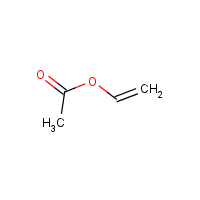Vinyl acetate
Agent Name
Vinyl acetate
CAS Number
108-05-4
Formula
C4-H6-O2
Major Category
Other Classes

Synonyms
1-Acetoxyethylene; Acetate de vinyle [French]; Acetic acid vinyl ester; Acetic acid, ethenyl ester; Acetic acid, ethylene ether; Acetoxyethene; Ethanoic acid, ethenyl ester; Ethenyl acetate; Ethenyl ethanoate; Octan winylu [Polish]; Vinile (acetato di) [Italian]; Vinyl A monomer; Vinyl acetate; Vinyl acetate H.Q.; Vinyl acetate monomer; Vinyl ethanoate; Vinylacetaat [Dutch]; Vinylacetat [German]; Vinylacetate; Vinyle (acetate de) [French]; Vinylester kyseliny octove [Czech]; Zeset T; [ChemIDplus] UN1301
Category
Esters, Other
Description
Colorless liquid with a pleasant, fruity odor. [Note: Raw material for many polyvinyl resins.]; [NIOSH] Polymerizes when exposed to light; [ACGIH]
Sources/Uses
Used in the production of polyvinyl acetate emulsions, acrylic fiber, and polyvinyl alcohol; Occupational exposure occurs in production workers, painters, and floor layers; [ACGIH]
Comments
Vinyl acetate causes eye and respiratory irritation in production workers. Experimental animals show minor elevation of liver function tests after IP injection and central nervous system depression after inhalation; [ACGIH] A lachrymator; [CHEMINFO] May cause skin redness and blisters; A skin, eye, and respiratory tract irritant; [ICSC] Vinyl acetate, stabilized (UN1301) has warning of explosive polymerization; [ERG 2016]
Biomedical References
Exposure Assessment
Skin Designation (ACGIH)
Insufficient data
TLV (ACGIH)
10 ppm
STEL (ACGIH)
15 ppm
Vapor Pressure
115 mm Hg
Odor Threshold Low
0.36 ppm
Odor Threshold High
0.5 ppm
Lethal Concentration
LC50 (rat) = 3680 ppm/4h
Explosive Polymerization
Yes
Explanatory Notes
Reported odor thresholds; [ACGIH]; Flash point = -8 deg C, closed cup; [ACGIH] VP = 90.2 mm Hg at 20 deg C /extrapolated; [HSDB]
Half Life
Whole body (animal studies): less than 6 hours; [TDR, p. 1218]
Reference Link #2
NFPA
may ignite at ambient temp
ERPG-1
5 ppm
ERPG-2
75 ppm
ERPG-3
500 ppm
Adverse Effects
Lachrymator
Yes
Neurotoxin
Acute solvent syndrome
Hepatotoxin
Hepatoxic (a) from occupational exposure (secondary effect) or (b) in animal studies or in humans after ingestion
Dermatotoxin
Skin burns
IARC Carcinogen
Possible (2b)
ACGIH Carcinogen
Confirmed Animal
Diseases, Processes, and Activities Linked to This Agent
Diseases
Occupational diseases associated with exposure to this agent:
Processes
Industrial Processes with risk of exposure: